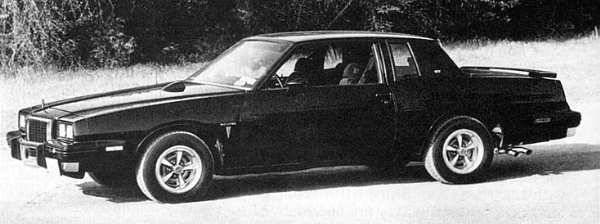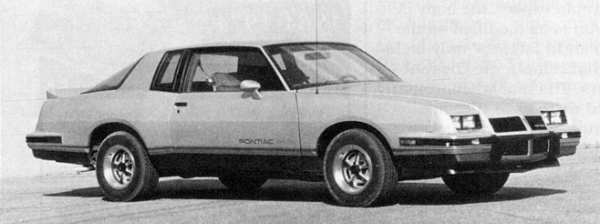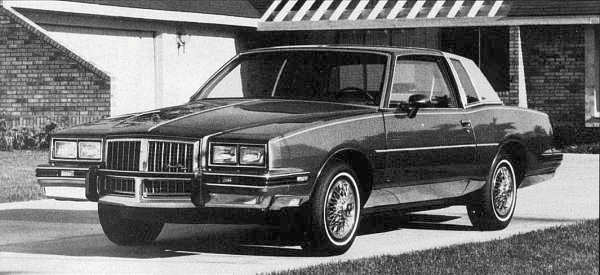
Above: Dante Gentile's Grand Prix GT—before it was stolen. |
Below: 1986½ Grand Prix 2+2.
 |
Grand Prix 2+2 and GT
The 1986 model year was significant because it was the only year for the Grand Prix 2+2, a NASCAR-inspired street machine. Taking the name from the famous Catalina-bodied pavement shredder of the mid-'60s, the 2+2 was designed and built to homologate the body style for NASCAR competition.
The body modifications that separated the standard GP from the 2+2 were obviously implemented to give NASCAR Pontiac racers an aerodynamic advantage. In fact, it was "The King" himself, Richard Petty, who originally proposed the idea of an aero-style GP for high-banks racing. Richard Petty Enterprises built a prototype of such a vehicle in 1983.
The production 2+2 was indeed a slippery piece. Up front, the fascia panel was constructed of urethane and was heavily sloped. The grille was of a honey mesh pattern, and a front spoiler provided additional cooling and reduced wind resistance.
The rear section of the car was also heavily modified. The aerodynamically inefficient notchback roof design was smoothed over with a large bubble-like rear window and an abbreviated rear trunklid with a spoiler. The trunklid itself covered a very small opening, which would just barely admit a space-saver spare tire.
With a limited production run of only 1,118 units, the body style was not seen as an economically feasible alternative. The lack of a hatchback arrangement did in fact make it a cumbersome grocery-getter. Unfortunately, the performance of the 2+2 was not quite as exciting as its racy exterior might suggest. The only available powerplant was a 165-hp 305 4-barrel hooked to a 4-speed automatic transmission. This was the same powerplant one could order in a regular GP. It was a far cry from the 190-horse High Output 305 that came in the Monte Carlo SS of the same period.
The exterior of all regular-production 2+2s came only one way— with an attractive two-tone paint scheme featuring silver above the beltline, charcoal gray below and red accent striping between, plus blacked-out window trim. All 2+2s were "no-option" vehicles, meaning they only came fully loaded.
It is reported that a couple of "brass hat" cars were maroon, although the only one the author has seen was a prototype with a wild rear deck spoiler replacing the bubble roof.
Although the 2+2 fell short in terms of performance, you can't complain too much when you consider that the car was the result of Pontiac's desire to further its factory racing efforts. That sort of thinking had not been seen since January 1963, when GM pulled out of racing.
Another specialty GP offered at this time was the Grand Prix GT, from Myrtle Motors of Middle Village, N.Y. The GT featured a standard-issue 305 4-barrel hooked to a 4-speed automatic. It received a black exterior with matching blacked-out trim, rear deck spoiler and Rally II wheels shod with 215/65R-15 Goodyear Eagle GT radials. According to the Myrtle Motors sales department, they were not allowed to make any mechanical modifications due to emissions regulations. As it turned out, less than 20 GTs were sold.
When the 1987 model year rolled around, the Grand Prix 2+2 did not return. This would prove to be the final year for the G-body GP. After years of non-development and being lost in the crowd, the rear-drive GP was finally put to rest.
NEXT >
1987 Grand Prix Brougham.
 |
|
|